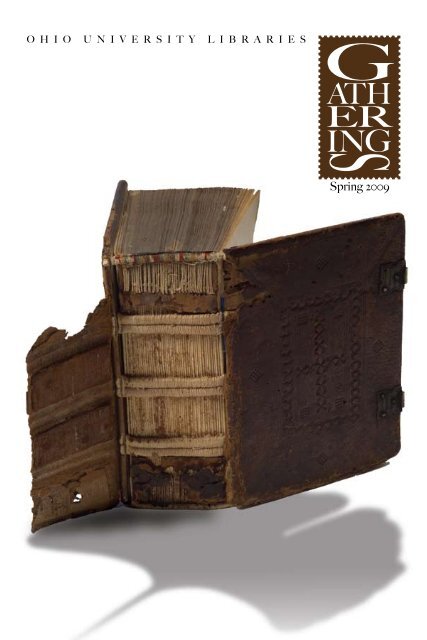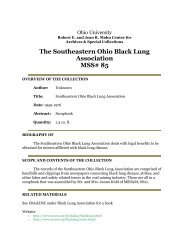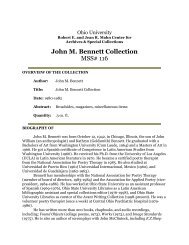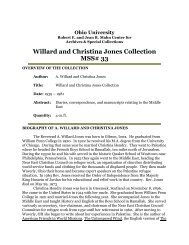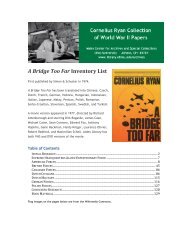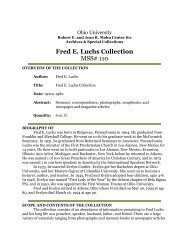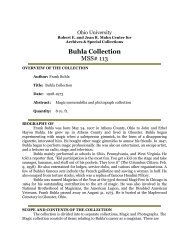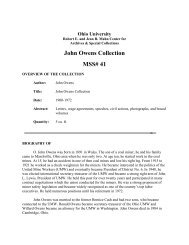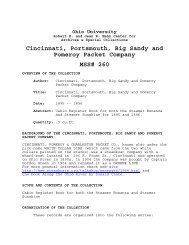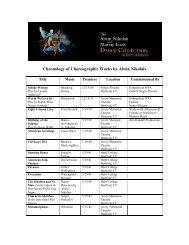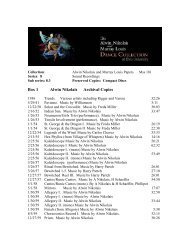Spring 2009 - OHIO University Libraries
Spring 2009 - OHIO University Libraries
Spring 2009 - OHIO University Libraries
You also want an ePaper? Increase the reach of your titles
YUMPU automatically turns print PDFs into web optimized ePapers that Google loves.
O h i o U n i v e r s i t y L i b r a r i e s<br />
<strong>Spring</strong> <strong>2009</strong>
LEARNING AROUND<br />
THE CLOCK<br />
PG 2<br />
LEARNING COMMONS<br />
PG 4<br />
HIGH SPEED HELP<br />
PG 6<br />
ROYAL DISCOVERIES<br />
PG12<br />
E.W. SCRIPPS PAPERS<br />
PG 8<br />
PROFILE OF<br />
A PRESIDENT<br />
PG11<br />
WRITING CENTER<br />
SUCCESS<br />
PG14<br />
OUR DONORS<br />
PG16<br />
Credits<br />
Dean of <strong>Libraries</strong>: Scott Seaman<br />
Editor: Kate Mason<br />
Co-Editor: Student Assistant, Meredith Barnett<br />
Design:<br />
• Design: <strong>University</strong> Communications and Marketing<br />
• Graphic Design Manager: Peggy Sattler<br />
• Design Intern: Katherine Davis<br />
• Student Assistant, Collections Access: David Black<br />
Photography:<br />
• Graduate Intern: Alysia Burton<br />
• Student Assistant, Visual Resources: Sherry DiBari<br />
• Graduate Intern: Kristin Heinichen<br />
Contributing Writers: Meredith Barnett, Chad Boeninger, Janet Carleton, Don Dudding,<br />
Marne Grinolds, Kate Mason, Sherri Saines, Jeff Shane, and Paul Shovlin.<br />
About the cover:<br />
Our cover depicts the spine of a 1482 treatise on canon law, Supplemenum Summae Pisanellae,<br />
revealing the exposed “gatherings.” In this case, “gatherings” refers to an assemblage of sheets<br />
of folded paper, sewn together to make the sequential pages of a book. This technique was an<br />
important innovation in the history of bookmaking. Today, “gatherings” holds another meaning<br />
for students and librarians—Alden Library has become the campus gathering place for students<br />
to complete collaborative assignments and projects.<br />
Ohio <strong>University</strong> is an affirmative action institution. ©<strong>2009</strong> Ohio <strong>University</strong> Communications and Marketing 0616-1.2M
From the Dean<br />
of the <strong>Libraries</strong><br />
This year, the staff at the Ohio<br />
<strong>University</strong> <strong>Libraries</strong> will celebrate the 40th<br />
anniversary of the opening of the Vernon<br />
R. Alden Library. Although the <strong>University</strong><br />
<strong>Libraries</strong> have been housed in many<br />
buildings on campus, none have had the<br />
presence or capacity of Alden. Another<br />
important milestone in the <strong>Libraries</strong>’ 190-<br />
year history also occurs in <strong>2009</strong> with the<br />
acquisition of our three-millionth volume.<br />
This is truly a testament to our rich and<br />
growing collections.<br />
In the nearly two centuries it took to acquire<br />
three million volumes, and especially<br />
over the last forty years, the <strong>Libraries</strong><br />
have undergone extraordinary change.<br />
We have moved from a print world in<br />
which information was scarce and highly<br />
organized to a networked world in which<br />
information is ubiquitous and uncontrolled.<br />
The way we access knowledge and<br />
information has also changed, and Ohio<br />
<strong>University</strong> <strong>Libraries</strong> have adapted to<br />
these changes. Book collections remain<br />
important, but electronic journals and<br />
databases now comprise well over half<br />
of our acquisitions. Though quiet study<br />
spaces still remain in Alden Library, our<br />
most heavily used areas are those for group<br />
study and collaborative work. Librarians still<br />
staff the reference desk but, increasingly,<br />
questions come through Skype, instant<br />
messaging, e-mail, and Facebook.<br />
Dean Scott Seaman<br />
such rich traditions, librarians so focused<br />
on the future, and students who regard<br />
Alden Library as a center for academic<br />
and social support. We look forward to<br />
celebrating our 40th anniversary and<br />
adding our three-millionth volume. Equally<br />
important, though, we look forward to<br />
continuing to offer resources for discovery,<br />
a virtual hub, a late-night place to study,<br />
and countless other resources students,<br />
faculty, and the community use at Alden<br />
Library. In the future, we will continue<br />
to adapt and evolve to meet the needs<br />
of the Ohio <strong>University</strong> community, while<br />
maintaining a reputation for dedicated staff<br />
and innovative services.<br />
Sherry DiBari<br />
As the new Dean of Ohio <strong>University</strong><br />
<strong>Libraries</strong>, I am proud to join a library with<br />
Scott Seaman,<br />
Dean of Ohio <strong>University</strong> <strong>Libraries</strong><br />
1
L EARNIN G<br />
Around the Clock<br />
By Sherri Saines<br />
Ohio <strong>University</strong> student Abby Shoaf poses on the floor of the Learning Commons at<br />
Vernon R. Alden Library. It is not uncommon for Shoaf to take cat naps at the library while<br />
studying and working on her computer until the wee hours of the morning.<br />
Kristin Heinichen<br />
2
Sleep isn’t necessarily the highest thing on my priority<br />
list,” says one of Alden’s late-night regulars, senior Abby<br />
Shoaf. A transfer student from Pickerington, Ohio, Abby<br />
discovered the Learning Commons, the library’s second floor<br />
hub filled with computers, study rooms and cozy corners for<br />
studying, soon after beginning her studies as a social work<br />
major at Ohio <strong>University</strong>. As a night owl, it was a “huge<br />
relief” to find a place open and inviting 24 hours a day, five<br />
days a week. She calls the second floor her safe haven, the<br />
place where she “doesn’t fall asleep.” It’s free, it’s quiet<br />
enough, and it offers minimal distractions with a pleasant<br />
buzz of community.<br />
The Learning<br />
Commons’<br />
Café Bibliotech<br />
sold the following<br />
during 2008:<br />
Cups of coffee<br />
and espresso:<br />
21,887<br />
“I can say I’m going to study in my room, but I just get<br />
distracted,” says Abby, so she comes to Alden many nights,<br />
usually from about 11:30 to about 2 am – if not all night – to<br />
get her work done.<br />
She thinks the set-up here “shows attention to what the<br />
young adult community needs,” calling the Commons<br />
surprisingly “functional and open.” She doesn’t have a<br />
printer at home, or a really comfortable chair, and those<br />
things are here in abundance. Because she is a transfer<br />
student on a five-year plan, she has used several other college<br />
libraries. She says Alden is the biggest, most functional and<br />
most accessible library in which she has worked. The others<br />
“haven’t tried as hard to work with the students” to make a<br />
library all it could be.<br />
The Café Bibliotech is also a big draw for this coffee lover.<br />
The fact that the coffee is Fair Trade is a bonus, not to<br />
mention that it is cheaper than at other cafés.<br />
Abby notes the Commons staff has been extremely kind and<br />
helpful. They showed her how to use the catalog to find<br />
a book of Spanish verb conjugations, for example. Derek<br />
Malone, overnight supervisor, even helped her figure out<br />
how to use the Statistical Package for the Social Sciences<br />
(SPSS) software.<br />
“As many times as I bug him, he’s always nice to me,” she<br />
says. The overnight staff does get to know the late nighters;<br />
it seems owls flock together and a community evolves. Abby<br />
even confesses that some of those all-nighters were more<br />
about socializing than studying.<br />
Muffins, croissants<br />
and slices of<br />
banana bread:<br />
8,060<br />
Cans of “Red Bull ® ”:<br />
4,950<br />
37% of<br />
“Red Bull ® ”<br />
was sugar-free<br />
The library fills many niches for many different student<br />
needs, and the overnight world of the Learning Commons<br />
is its own comfortable place for some Ohio <strong>University</strong><br />
students with nocturnal leanings. Like many students, Abby<br />
acknowledges how important Alden Library is to her. Abby’s<br />
only suggestion for improvement is to have more floors open<br />
all night!<br />
3
L EARNING COMMON S<br />
A Study in Success<br />
The Learning Commons has never been empty. “Fall quarter<br />
2007, finals week: at 1 a.m., there were 400 students sitting at<br />
108 computers, 29 study tables, 52 sofa seats, 70 group study<br />
room chairs, 49 café seats, 47 extra chairs—and 45 huddled<br />
around their laptops and books on the floor!”<br />
–Cathy Sitko, Reference Dept.<br />
A typical afternoon in the Learning Commons.<br />
Kristin Heinichen<br />
Scott Ketner, 20, a sophomore, studies<br />
German Language and Culture inside<br />
the Learning Commons of Alden Library.<br />
Alysia Burton<br />
4
Thank you to all the donors who made the Learning Commons possible.<br />
In the Learning<br />
Commons:<br />
Classes offered<br />
about library<br />
resources in 2008:<br />
1,159<br />
Media Library<br />
items borrowed<br />
last year in 2008:<br />
87,331<br />
Shannon Lee (left), 21, and a junior, studies accounting with freshman<br />
Jermain Onye, 19 inside the Learning Commons of the Alden Library.<br />
Alysia Burton<br />
Times that all<br />
50 laptops were<br />
loaned during fall<br />
quarter 2008:<br />
9,470<br />
Caylee Heiremans<br />
eats at Café<br />
Bibliotech<br />
while studying for<br />
her upcoming class.<br />
Kristin Heinichen<br />
Reference<br />
questions answered<br />
since 2004:<br />
269,163<br />
Writing Center<br />
sessions held<br />
in 2008:<br />
4,284<br />
5
Chad Boeninger holds his<br />
Webcam camera, which is one<br />
way he transfers information<br />
and instruction to those seeking<br />
troubleshooting, tutorials and<br />
reference services. Boeninger<br />
is a Reference & Instruction<br />
Librarian, web manager<br />
and Business & Economics<br />
Bibliographer at Vernon R.<br />
Alden Library.<br />
High-Speed<br />
Put the Library on Your Buddy List<br />
BY CHAD BOENINGER<br />
6
[14:10] student: i have a question<br />
[14:11] ohiolibref: ok<br />
[14:11] ohiolibref: how can i help you<br />
[14:11] student: i found an article i want to print but there is no option to view the<br />
aritcle or view pdf<br />
[14:11] student: and when i click on find it, it says there is no print article found<br />
[14:11] ohiolibref: hmmm, it may only be in print. what is the article?<br />
[14:12] student: http://web.ebscohost.com/ehost/detail?vid=5&hid=109&sid=d5f156bf-e918-4-<br />
fca-97cb-7dc3306849ae%40sessionmgr109<br />
[14:13] ohiolibref: you are correct. not only is this not in full text, but we do not have a print copy<br />
[14:13] student: so there’s no way to see it?<br />
[14:13] ohiolibref: that is the one problem with databases. we have lots of what is in the database<br />
in print or electronic, but some stuff we don’t<br />
[14:13] ohiolibref: i would say no, unless you can find it on google...sometimes that can happen<br />
[14:13] student: alright. thanks<br />
[14:14] ohiolibref: i bet you can find other things though<br />
[14:14] ohiolibref: have you had luck with other resources?<br />
[14:16] student: i’ve only looked on the databases<br />
[14:16] ohiolibref: ok. there should be plenty to find in databases, although i don’t know<br />
what your topic is!<br />
[14:16] student: Liberian Environment<br />
[14:17] student: its harder than it sounds, everything is about the war in liberia<br />
[14:17] ohiolibref: so, environmental issues in liberia<br />
[14:18] student: ya<br />
[14:18] ohiolibref: do you have a sec? i can try a search too<br />
[14:18] student: ya<br />
[14:20] ohiolibref: i only searched on ACADEMIC SEARCH COMPLETE and ENVIRONMENT COMPLETE<br />
[14:20] ohiolibref: and i searched<br />
[14:20] ohiolibref: Liberia* and environ* (liberia, liberian, environment, environmental, etc.)<br />
[14:21] ohiolibref: i got about 70 hits, some look helpful<br />
[14:21] student: ok i’ll try that<br />
[14:21] ohiolibref: if that doesn’t help also try a database called<br />
[14:22] ohiolibref: PAIS (you need to get it via INFOTREE)<br />
[14:22] ohiolibref: Public Affairs Info System (it might have stuff too)<br />
[14:22] student: ok i didn’t know about that<br />
[14:22] ohiolibref: but it helps to truncate (environ*)<br />
[14:22] ohiolibref: is all this making sense?<br />
[14:23] student: yes<br />
[14:23] student: i got the whole 3 day library lesson last week<br />
[14:23] student: it was good timing for this project<br />
[14:23] ohiolibref: excellent. please come back if you need more help, or stop by ref<br />
desk 2nd floor<br />
[14:23] ohiolibref: so you found the library session helpful?<br />
[14:24] student: yes<br />
[14:24] student: SO much more info than google if you know how to use it<br />
[14:24] ohiolibref: i’m glad. sometimes if feel like we are speaking in tongues. you are<br />
my star student today!<br />
[14:24] student: haha cool<br />
Help:<br />
[14:25] ohiolibref: can I keep your transcript? seriously<br />
Kristin Heinichen<br />
“Hi, is<br />
real librarian?” a message from<br />
a student reads on the computer screen.<br />
“Yes, I’m a librarian, how<br />
can I help you?” the librarian<br />
types back.<br />
this a<br />
Thus begins another reference transaction<br />
between a librarian and a patron via<br />
instant messaging (IM). Since 2005, the<br />
Alden Library Reference Department has<br />
answered more than 13,000 questions<br />
through its instant messaging service.<br />
The department started the service<br />
in July 2005 to make librarians more<br />
available to patrons. As many college<br />
students prefer instant messaging as a<br />
means of communication, offering the<br />
option for reference service proved to<br />
be a no-brainer. Along with the services<br />
at the reference desk, over the phone,<br />
and via email, the IM service allows<br />
students instant contact with a librarian.<br />
The service is booming, largely because<br />
librarians are available during every hour<br />
the Learning Commons is open.<br />
“We’re proud of the fact that we have<br />
one of the most active virtual reference<br />
programs in the state, perhaps in the<br />
country,” boasts Reference Department<br />
Head Wanda Weinberg. “Because we<br />
staff the service 134 hours a week, we<br />
often have more questions at night than<br />
during the day.”<br />
Students appreciate this service because<br />
they can talk to a librarian anonymously,<br />
they don’t have to approach what can be<br />
an imposing desk, and they don’t have to<br />
leave the computer station where they are<br />
working. No matter if students are on<br />
the 6th floor of Alden, at their parents’<br />
house in Cleveland, or studying abroad in<br />
Italy, the service instantly connects them<br />
with an expert who is able to help them<br />
with research.<br />
7
The<br />
E.W. Scripps<br />
Papers<br />
By Janet Carleton<br />
8
Edward Willis Scripps (1854 – 1926)<br />
was one of America’s pioneering<br />
newspaper publishers, a man with<br />
the “heart of a dirt farmer, the<br />
soul of a poet and the flaming brain<br />
of a crusading newspaper publisher,”<br />
according to Vance Trimble, who penned<br />
The Astonishing Mr. Scripps: The Turbulent<br />
Life of America’s Penny Press Lord.<br />
Despite being a respected correspondent<br />
to high-ranking political and intellectual<br />
figures, Scripps preferred to keep a low<br />
public profile, relying instead upon his<br />
newspapers to speak for him.<br />
In 1988, Charles E. Scripps donated his<br />
grandfather E.W. Scripps’<br />
personal and business<br />
papers, as well as other<br />
documents received<br />
by Scripps from family,<br />
friends, business associates,<br />
and employees to Ohio<br />
<strong>University</strong> <strong>Libraries</strong>. Over<br />
the next two years, library<br />
staff spent an enormous<br />
amount of time processing<br />
and making the collection<br />
available, celebrating its<br />
public opening in 1990.<br />
Recently, the library has<br />
undertaken the task of<br />
digitizing the collection to<br />
make it available for future generations.<br />
Thanks to these efforts, the legacy of<br />
E.W. Scripps—whose work changed<br />
American journalism—can now live on<br />
into the new digital age.<br />
Availability<br />
Scripps had many interests beyond<br />
newspapers, and his correspondence<br />
offers a rich glimpse into the issues of<br />
the time. Housed in the Robert E. and<br />
Jean R. Mahn Center for Archives and<br />
Special Collections on the fifth floor of<br />
Alden Library, the E.W. Scripps Papers<br />
“It is my belief<br />
that the greatest<br />
assistance is<br />
rendered society<br />
by that business<br />
organization of<br />
publicity which<br />
is called the<br />
daily paper.”<br />
— E. W. Scripps<br />
contain his correspondence on topics<br />
from politics to science to projects for<br />
the public good, such as charities, parks<br />
and preserves, roads, and public works.<br />
Although the Scripps Papers provide<br />
a rich treasure trove of information<br />
for researchers, faculty and students, it<br />
became apparent after their acquisition<br />
that the fragile nature of the paper, along<br />
with increased usage, was causing wear<br />
and tear. To meet these challenges,<br />
Alden Library began charting a course<br />
of action to ensure protection of this<br />
invaluable resource for future generations<br />
by establishing a digitization program.<br />
The term digitization, in<br />
this instance, describes<br />
a multi-faceted process<br />
which includes selecting<br />
materials, securing<br />
funding, conducting<br />
background research,<br />
ensuring copyright<br />
clearance, capturing<br />
images, managing files,<br />
creating user interfaces,<br />
and doing outreach.<br />
The digitization of<br />
cultural heritage materials<br />
is a labor-intensive<br />
business. Capturing<br />
high-quality images from fragile materials<br />
handled in a secure environment requires<br />
skill and an eye for color to replicate,<br />
as closely as possible, the experience of<br />
viewing the original document. The<br />
most challenging, and arguably the most<br />
important piece of the puzzle, is creating<br />
the “metadata,” the descriptive terms that<br />
enable users to locate and sort through<br />
specific online material.<br />
Digitization is becoming increasingly<br />
important in libraries across the country.<br />
9
“Cultural heritage institutions always try<br />
to balance the needs of our users with<br />
the needs of the collections,” says Laurie<br />
Gemmill, digital manager at the regional<br />
library network PALINET. “However,<br />
our users are no longer asking whether<br />
our collections are available online, they<br />
[are] simply presuming the collections are<br />
available to them online 24/7… Many<br />
users want to use the materials in person<br />
but many more… only find and use<br />
materials if they are online.”<br />
The Importance of the Collection<br />
Maintaining a digital online presence<br />
for the Scripps Papers fills dual<br />
responsibilities: access and preservation.<br />
In addition to the convenience, online<br />
digitization offers accessibility for<br />
remote researchers through a simple<br />
web search, with an added bonus to<br />
the user to “zoom in” on an image for<br />
up-close details. Online digital presence<br />
also preserves the fragile collection<br />
by decreasing the wear and tear on<br />
documents caused by multiple handlings.<br />
“Having the digital resources available to<br />
access all of Scripps’ information is helpful<br />
for everything from understanding what’s<br />
going on in the news media today to<br />
what the Scripps organization is doing,”<br />
said undergraduate journalism major<br />
Chelsea E. Toy.<br />
“It’s important to be able to access this<br />
type of correspondence for our day-today<br />
work.”<br />
Currently, there are 1,200 documents<br />
online, primarily letters and memos<br />
penned by Scripps, but this only<br />
represents a small portion of the print<br />
collection—many thousand remain to be<br />
digitized. A small number of photographs<br />
of the Scripps family have been added for<br />
visual interest.<br />
The E.W. Scripps Papers is thought to<br />
be the only publicly-accessible archive<br />
documenting the inner workings of a<br />
major newspaper publishing business.<br />
His papers are significant for more than<br />
journalistic purposes, though: Scripps<br />
was an innovator who influenced public<br />
policy, funded scientific research and<br />
emerged as a champion of the working<br />
man. The collection stands as a treasury<br />
from one of America’s pioneering public<br />
figures. Providing digital online access to<br />
this collection, though a great challenge<br />
for Ohio <strong>University</strong> <strong>Libraries</strong>, is an<br />
important one. Perhaps Scripps, himself a<br />
man who devoted his life to the business<br />
of information, would be humbled to<br />
see his illustrious work surviving into the<br />
digital age.<br />
To view the online collection visit:<br />
http://media.library.ohiou.edu/scripps<br />
10
Profile of a President<br />
By Kate Mason<br />
When I was first asked to write<br />
a profile on Dr. Greg Kremer, President of<br />
the Friends of the <strong>Libraries</strong>, I envisioned<br />
him flying by on his early morning bike<br />
commute from his Coolville Ridge home.<br />
He rides for fun too, and when he<br />
does, like on his memorable trip to the<br />
Continental Divide, Dr. Kremer likes to hop<br />
on his mountain bike and ride for hours.<br />
“The overall experience is what excites<br />
me,” he said. “The way you ride a trail is<br />
not to look at the obstacles, but focus on the<br />
best path through them.”<br />
Dr. Greg Kremer<br />
Kristin Heinichen<br />
Off the trail, Dr. Kremer is a global and<br />
local community builder. He is an active<br />
member of the Green Build Committee for<br />
Habitat for Humanity and an Executive<br />
Committee member of the Sierra Club,<br />
as well as the President of the Friends—<br />
libraries being one of his passions.<br />
With a chuckle, Dr. Kremer fondly recalls<br />
how as a young boy, he and his mom went<br />
to the library for “our weekly jaunt to the<br />
city to grab a bag of books,” he said. “I<br />
still love to wander into the Fine Arts section<br />
to open my perspective.” In his next breath,<br />
he links the past with the present, speaking<br />
about the importance of libraries and his<br />
involvement today as the president of<br />
the organization.<br />
“(Our) most important role is one of<br />
advocacy and awareness-building,”<br />
he said. “(We) do whatever we can to<br />
engage others to become a Friend of<br />
the <strong>Libraries</strong>.”<br />
This, however, is only a small glimpse<br />
inside the life of Dr. Kremer, chair of the<br />
Department of Mechanical Engineering<br />
and the department’s car specialist.<br />
I discovered that Greg really loves<br />
cars, which inspired him to become a<br />
mechanical engineer.<br />
“I grew up with vehicles of all kinds, first<br />
bikes which I took apart and put back<br />
together,” he said, “and as I got up to the<br />
level of cars, I learned how to fix them. A<br />
lot of us guys like things that go fast.” Dr.<br />
Kremer is currently working with graduate<br />
student Todd Steigerwalt on a prototype<br />
ammonia-fueled vehicle.<br />
Whether in the classroom or on the trail,<br />
Dr. Kremer seeks awe-inspiring journeys.<br />
In 2006, while mentoring Ohio <strong>University</strong><br />
students participating in Engineers Without<br />
Borders, Dr. Kremer and his contingent<br />
spent three weeks in Ghana building<br />
duplex housing to attract new teachers to<br />
the region, and in 1992, he and his cousin<br />
Matt took a hiking trip to Long’s Run Peak<br />
in Colorado. One photo from the trip on<br />
his website has a caption that reads, “All<br />
work and no play is not good at all.” It<br />
seems to be a motto by which Dr. Greg<br />
Kremer lives.<br />
11
Urangkhathat Thetsana (palm leaf manuscript)<br />
Royal DiScoverieS<br />
Spotlighting Two Volumes from the David K. Wyatt Thai Collection<br />
By Jeff Shane with photos by Kristin Heinichen<br />
In 2005, Ohio <strong>University</strong> <strong>Libraries</strong> purchased the private library<br />
collection of Cornell <strong>University</strong> historian David K. Wyatt.<br />
Consisting of roughly 15,000 volumes, about half of which are<br />
written in Thai, the collection includes standard works on Thailand<br />
and Southeast Asia, Thai royal chronicles, the diaries and letters of<br />
beloved monarch King Chulalongkorn (1868-1910), and an extensive array<br />
of monographs, memoirs, and cremation volumes. The Wyatt Collection is a<br />
vast treasure-trove of rare books and historical documents on Thailand.<br />
‘Atsatronomi (1875), part of the collection, is among the rarest of Thai<br />
books, one of only three known copies in existence. It is a Thai translation<br />
12<br />
The David Wyatt Collection is housed in the Hwa-Wei Lee Center<br />
for International Collections on the first floor of Alden Library.
of the text Elements of Astronomy (1867).<br />
What is most striking about ‘Atsatronomi<br />
is not its sophistication, or the accuracy of<br />
its translation, but what it reveals about the<br />
intellect of the Siamese ruler, King Mongkut,<br />
who commissioned its translation. Mongkut<br />
was anything but the self-important and<br />
uncultured monarch portrayed in Rodgers<br />
and Hammerstein’s flight of fancy, The<br />
King and I. Mongkut was a consummate<br />
man of letters, who was not only a gifted<br />
linguist, philosopher, and astrologer, but<br />
also an astronomer. In the words of one<br />
visitor, Mongkut possessed all the scientific<br />
“instruments which might be found in the<br />
study or library of an opulent philosopher in<br />
Europe.” In fact, it was King Mongkut who<br />
predicted with astonishing precision the solar<br />
eclipse of 1868, much to the chagrin of the<br />
visiting delegation of European astronomers,<br />
who hoped, no doubt, to prove the<br />
King wrong.<br />
Also part of the Wyatt Collection is the<br />
commemoration volume Chotmaihet ruang<br />
rap Phraya Sawetkunchon. Originally penned<br />
in 1812 on dried palm leaves, as was formerly<br />
the custom, this volume chronicles the capture<br />
Phrabat Somdet Phra Chomklao Chao Krung Sayam<br />
Prachum Phongsawadan<br />
of the first white elephant during the<br />
reign of King Phutthalœtla (1809-1824).<br />
The Asian elephant has occupied a central<br />
position in Thai culture for centuries,<br />
regarded as a noble creature and a<br />
symbol of strength, virility and wisdom.<br />
The rare white (albino) elephant is of a<br />
higher order still. According to Buddhist<br />
beliefs, a white elephant, being the<br />
preferred abode of transmigrating souls,<br />
is sacred. Possession of a white elephant<br />
was considered a badge of distinction,<br />
and historically, only the Siamese King,<br />
the highest of the earth-bound celestial<br />
beings, could lay claim to one. King<br />
Phutthalœtla is believed to have possessed<br />
six white elephants, and his most prized<br />
elephant, Phraya Sawetkunchon, the<br />
subject of this book, was given a royal<br />
title and served with all the pomp and<br />
magnificence befitting such a<br />
majestic beast.<br />
These are just two of the many treasures<br />
to be found in the Wyatt Collection,<br />
housed on the first floor of Alden Library.<br />
Many more riches await scholars and<br />
students of Thailand, all thanks to the<br />
late David K. Wyatt who entrusted us to<br />
care for and preserve his extraordinary<br />
collection.<br />
13
Student Writing<br />
Center Success Story<br />
In the fall of 2006, Ohio <strong>University</strong><br />
graduate student Talinn Philips and<br />
the two of us, Paul Shovlin and Don<br />
Dudding, completed our doctoral<br />
exams and suddenly found ourselves<br />
confronted with the same problem: writing<br />
our dissertations. Fortunately for us, we<br />
were able to take advantage of a graduate<br />
student writing group, one of Alden<br />
Library’s programs through the Student<br />
Writing Center, and began<br />
to meet regularly, both in<br />
person and virtually, to<br />
pound out each chapter.<br />
The Student Writing Center<br />
has been organizing student<br />
writing groups for the<br />
last five years. There are<br />
usually three to five groups<br />
per year, although groups<br />
routinely shift and change.<br />
Our particular group formed<br />
because the three of us<br />
were familiar with each<br />
other, both personally and<br />
professionally, from our<br />
work in the Rhetoric and<br />
Composition program in the<br />
English Department. Other<br />
groups consist of students<br />
from different disciplines.<br />
By Paul Shovlin and Don Dudding<br />
week the group would focus on the latest<br />
submission and offer helpful comments<br />
concerning anything from basic style to<br />
key disciplinary issues. Talinn was working<br />
on an ethnographic study of international<br />
students’ use of the Student Writing<br />
Center’s tutoring services. Don focused<br />
his work on classical rhetoric and theorized<br />
a pedagogy that put students first. Paul<br />
developed a critical pedagogy essentially<br />
Over the next few months,<br />
the group changed, as some<br />
members left and others<br />
were added, but it eventually<br />
solidified and kept the same<br />
membership for two years.<br />
The rules for the writing<br />
group were simple. On a<br />
rotating basis, each member<br />
of the group agreed to take<br />
a turn submitting writing,<br />
whether it was a page or<br />
an entire chapter. Each<br />
Kristin Heinichen<br />
14
ased on the integration of advanced<br />
technologies in writing classes.<br />
Perhaps even more important than<br />
the writing feedback was the sense of<br />
community that developed among the<br />
group members. Knowing that people<br />
were struggling with the same issues<br />
of juggling work, family, personal and<br />
professional obligations helped make a<br />
difficult process bearable.<br />
“Of course it was valuable to have other<br />
intelligent and competent writers looking<br />
over our work,” explains Don. “But the<br />
feeling that we were sharing our lives with a<br />
group of people that we could be open with<br />
enabled us to be completely<br />
frank about the changes we<br />
suggested for each other.”<br />
For Paul, writing for the group helped<br />
him to be more productive. He says, “The<br />
writing process for a dissertation can drag<br />
on and on. Sometimes, it can feel like you<br />
are so far removed from your audience that<br />
you lose touch. Writing for people that were<br />
going to meet with me and discuss what<br />
I was writing caused me to become more<br />
engaged with the process.”<br />
Opportunities offered by the online writing<br />
environment, where students can meet<br />
virtually and work on their writing, were<br />
vital to this group’s success.<br />
Don says, “I work 45<br />
minutes south of the Athens<br />
campus, and another group<br />
member had to drive in<br />
from Columbus. So, if we<br />
didn’t have this electronic<br />
alternative, it would have<br />
been nearly impossible for us<br />
to meet and submit as often<br />
as we did.”<br />
In the spring of 2008,<br />
Talinn became the first<br />
member of the group to<br />
finish her dissertation and<br />
her degree. Since then, the<br />
group has remained socially<br />
connected and continues to<br />
offer each member support,<br />
but is no longer meeting<br />
on a weekly basis. Don and<br />
Paul plan on finishing their<br />
degrees before June <strong>2009</strong>.<br />
The road to completing a<br />
dissertation can be a bumpy<br />
one. But having good<br />
companions and support<br />
from the Student Writing<br />
Center makes the trip a<br />
little easier.<br />
Don Dudding and Paul Shovlin in Alden’s Faculty Commons.<br />
15
<strong>OHIO</strong> UNIVERSITY LIBRARIES<br />
thanks its 2008 donors for their extraordinary support:<br />
A & G Media Group LLC Gerard Raymond Ackerman Akron Association of O. U. Women Dr.<br />
Vernon R. Alden Melinda Armistead Penny D. Arsenault Athens Civitan Club Dr. George W.<br />
Bain & Dr. Nancy R. Bain Janice M. Baskey Mark C. Baughman Ann J. Baxter Nancy Beres<br />
Shirley Baxter Berndsen Janet Betcher Bruce Alan Bindas & Keely Jeanne Bindas Sheppard<br />
Black & Peggy S. Black Rt. Rev. William G. Black David P. Bloom & Carolyn H. Bloom Mary<br />
Christine R. Bogar Dr. Adam Bors & Ada L. Smalley Bors Kenneth L. Brier Dr. Catherine L.<br />
Brown Sydney E. Buck & Sonya D. Buck Dr. Karen G. Burch James R. Burkhard & Phyllis A.<br />
Burkhard Charles Gregory Bush & Rebecca Ann Bush Lindsay R. Carpenter Wilmont H.<br />
Chandler & Sallie A Roberts Marcy Libman Chaney Dr. Anthony G. Chila & Helen Chila Dr.<br />
Francine C. Childs Lora J. Clapp Columbus Foundation (HQ) Peter Colwell Margaret M.<br />
Condon Michael Coppola Glenn E. Corlett & Bonnilyn Corlett Helen Corns Donald Cox John<br />
A Cramer & Karen S. Cramer Donna M. Daniel Judith A. Daso Gerry Davidson David Lancelot<br />
Dean Dr. David N. Descutner Charles B. DeVinney Gloria I. Devol Dr. Howard D. Dewald &<br />
Elaine F. Saulinskas Mary Dobbins-Bucklad Rita Doran Ms. Joyce A. Douglas Dr. Gifford B.<br />
Doxsee Dr. Jean Drevenstedt Janet S. Duerr Ruth Anna Duff Clifford C. Dukes Janice L.<br />
Dumford Darby H. Duncan Holly Duncan Dr. Richard R. Duncan Jeffery A Eberlein Richard<br />
E. Edgar & Eleanor Edgar Kenneth B. Edwards & Deborah J. Edwards Charles R. Emrick Jr. &<br />
Lizabeth K. Emrick Richard H. Essex & Jessie C. Essex Robert E. Fallon & Joanne Fallon Robin<br />
A.C. Fearn Jeffrey Lee Ferrier & Lisbeth Ferrier Estate of David A. Fieler, Sr. Jean Fair Fieler<br />
Robert A Fischer Carol Fisco Maribeth Fisher John R. Fleeman C. Howard Fokes & Dr. Schuyler<br />
E. Cone Barbara L. Foraker Theodore S. Foster & Katharin K. Foster Robert G. Frasch Martha<br />
Gale Frew Larry D. Frey & Ann Frey Leonard I Frieling Friends of Mabel Latham Friends of<br />
the Library Dr. Richard M. Fulks & Annabelle B. Fulks Dr. John C. Fuller Beverly Gage Estate<br />
of David A. Gardner David R. Gedeon & Diana L. Gedeon John E. Geist & Cecilia Geist Christian<br />
S. Gerig & Kristina B. Gerig M. B. Gerig & Carin E. Gerig Paul J. Gerig & Lois H. Gerig Ismail A.<br />
Ghazalah John R. Gilliom & Amy A. King Judge L. Alan Goldsberry & Stephanie K. Goldsberry<br />
William S. Gorup Dorothy Nething Griffith Robert E. Guinn & Mildred P. Guinn Caryl Gustavson<br />
William Hafner Paula R. Haggard David R Hall Dr. Alonzo L. Hamby & Dr. Joyce Litton Hamby<br />
Gregory E. Hammer Timothy Harmon Dr. Frederick Y. Harris & Kazuko Harris Paula S. Harsch<br />
James C. Hart & Elizabeth F. Hart David J. Hartline Dr. Timothy P. Hartman & Kathy Hartman<br />
Dr. David G. Hendricker Michael J. Henry Jr. Kenneth B. Higbie & Dorothy J. Higbie Jennifer Ann<br />
Hill Anne E. Hinton Dr. John W. Hollow & Elizabeth P. Hollow Roberta W. Holzer Dr. Scott L.<br />
Hooper Elizabeth Ann Huber Sharon A. Huge Chenessa L. Hursey Ruth T. Ingham Dr. Anita<br />
C. James Ellen Pappas Jones Donald A. Jordan & Mary K. Jordan Mr. William J. Kaiser Patricia<br />
G. Kantner Dr. John L. Keifer & Dr. Mary C. Keifer Ted King & Cynthia K. King Laura E. Kinner<br />
Dr. George R. Klare Pamela S. Klein Michael Kleinman & Ann Kleinman Mary J. Kline Don B.<br />
Knapp II & Patricia Knapp Dr. Earl A. Knies & Elizabeth R. Knies Christine B. Knisely Gregory<br />
Gerard Kremer David Bryan Kurz & Helen J. Kurz Peter T. Lalich Jr. Dr. David Alan Lavine Cora<br />
A. Layaou Dr. Hwa-Wei Lee & Mary F Lee Sarah B. Levinson Dr. Carolyn B. Lewis LMNO<br />
Engineering, Research and Software Joyce Ann Martin Long Cynthia Wallace Love Dr. Thomas
G. Luce & Edith Ann Luce Robert E. Mahn Paul S. Malcom & Marjorie A. Malcom Edward<br />
Malkowicz & Michaele Kahny Malkowicz Dr. Arthur J. Marinelli Jr. & Kathleen A. Marinelli John C<br />
Marksbury Harriet Martin Dr. Rodger A. Marting George Masko Loyd G. Mbabu Edwin W<br />
Meier & Beth E. Meier Jeffrey Paul Miller & Karen Miller Robert L. Miller & Janie Rees Miller Robert<br />
G Moorehead Willard D. Moyer Jr. & Susan T. Moyer Brian Kent Mulliner & Lian H The-Mulliner<br />
Dr. James Allen Murray Sean Allen Music Alison Sara Nadvornik Dr. Gary B. North & Marty D.<br />
North Gerald J. Novack & Marlene Novack Linda A Novak Deborah O’Brien Kathleen D.<br />
O’Donnell Ohio <strong>University</strong> Credit Union Ohio <strong>University</strong> Emeriti Association Alan W. Olson & Nita<br />
J. Olson Dr. Charles Overby & Ruth Overby Tom Parker Estate of Ralph W. Parks, Jr. Jerry P.<br />
Peppers & Sue E. Peppers Dr. James W. Petersen & Lee S. Petersen Mr. Guy Clark Philips & Mrs. Linda<br />
Chambers Philips Richard D. Piccard & Diane Piccard Eileen A. Pickenpaugh Treva Ann Pickenpaugh<br />
Anthony R. Pierfelice & Leslie Pierfelice John S. Piety & Jean Z. Piety Dr. Charles J. Ping & Claire O.<br />
Ping Mary Anne Plefka-Weir Dr. Milton E. Ploghoft, Sr. & Zella Ploghoft Gregory T. Polzer & Janet<br />
N. Polzer Byron H Post Dr. Laurine Purola Dr. Betty P. Pytlik Richard E. Reed Kenneth L. Rhoads<br />
& Judith M. Rhoads Gail Richardson Dr. Daniel Riffe & Dr. Florence Clark Riffe Sean Michael Riley<br />
J. Brian Riordan Mark G Ritter Mary Roberts Stanley D. Robinson & Ann Robinson Dorothy L.<br />
Rodgers Jean W. Rohde Wanda Sue Rohrbough Mark E. Rollins & Joann K. Rollins James T Ross<br />
David E. Rosselot Douglas L. Rossiter & Rosemary Rossiter Jon F Rotenberg Thomas Joseph Roth<br />
Jean E. Roxon Nancy H. Rue Dr. Robert W. Russell & Lelia Roberts Russell Michele Cash Russo<br />
Barbara Ryan Richard W. Ryan William F. Sams & Janet L. Barnard Harriet H. Sandmeier Paul<br />
Santamaura Laralyn Marie Sasaki Vincent P. Scarmack Sr. & Dorothy F. Scarmack Karl L. Schaab<br />
& Lesley W. Schaab Kevin R. Schmucker Dr. Gary M. Schumacher & Kathleen S. Schumacher Scott<br />
Seaman Dr. You-Bao Shao Teri G. Sherman James C Shields Julia G. Shulman Dr. Reid B. Sinclair<br />
Dr. Patrick A Smith & Loraine M Chorey-Smith Sabrina Dawn Smith Dr. Timothy D. Smith & Barbara<br />
V. Smith Melanie Solomon Margaret Soltow Joel P Somerick Margaret E. Sondey Thomas A<br />
Speece & Yvonne M Speece John A. Stein Dr. Ray G. Stephens & Jean J. Stephens Claudette C.<br />
Stevens Judge Robert W Stewart Estate of Beth K. Stocker Mrs. Beth K. Stocker Elizabeth M.<br />
Story Lynn E. Straley Allen W. Strous Andrew P. Stuart Patricia Connor Study Nancy J. Thatcher<br />
The Staff of Ohio Univ. <strong>Libraries</strong> Holley Marker Thompson Alexander Topping & Margaret Topping<br />
Toyota Motor Sales U.S.A. Inc. (HQ) William P. Tuchrello William R. Turner & Mary Jane Turner<br />
Judith P. Vanke Dr. Richard K. Vedder & Dr. Karen P. Vedder Mr James Wakeley Mr. George L. Ware<br />
II & Mrs. Margaret F. Ware Dr. Richard A. Weber Mr. Alan I. Weinberg & Mary Ellin Weinberg Dr.<br />
Mark L. Weinberg & Wanda J. Weinberg Dr. Robert H. Whealey & Lois D. Whealey Samuel A. Wilen<br />
Alice L. Williams Dr. David L. Williams & Karen J. Williams Glenn C. Williams & Kirsten H. Williams<br />
Edward F. Wilsey Jr. & Elizabeth M. Wilsey Mr. Jeff Wilson & Janice Wilson Dr. William A. Withington<br />
Arthur Pahlen Woolley Gregory K. Wright & Cheryl K. Wright Kevin W. Wright James A. Wycoff &<br />
Suzanne K. Wycoff Susan Leibensperger Wylie Dr. David A. Young & Elaine Young Richard F.<br />
Zielinski & Mary Ilene Zielinski Julia A. Zimmerman Joseph W. Zurawski & Marcia K. Zurawski<br />
For more information please contact Doug Partusch,<br />
Director of Development at 740-593-2683 or partusch@ohio.edu
How We Stacked up for 2008<br />
Contact Information<br />
Gatherings is a publication of the Friends of the Ohio <strong>University</strong> <strong>Libraries</strong>.<br />
For more information, please contact: Kate Mason, 512 Alden Library,<br />
Athens, Ohio 45701<br />
740.593.2702<br />
<strong>University</strong> <strong>Libraries</strong><br />
Kristin Heinichen


